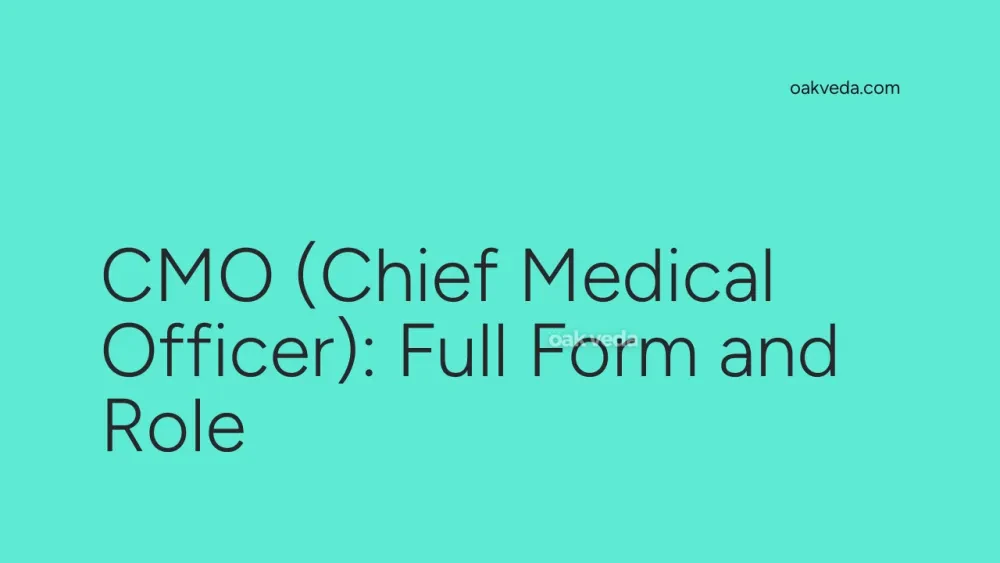
What is the Full Form of CMO?
The full form of CMO is Chief Medical Officer. This important acronym represents a senior medical professional who plays a crucial role in healthcare management and public health administration.
What is a Chief Medical Officer?
A Chief Medical Officer (CMO) is a high-ranking executive in the healthcare sector, typically responsible for overseeing medical operations, ensuring quality patient care, and making critical decisions regarding health policies and procedures. In government settings, a CMO is often a senior civil servant who heads the medical department of a government hospital or healthcare facility.
Origin and Development of the Chief Medical Officer Role
The concept of a Chief Medical Officer has evolved over time, adapting to the changing landscape of healthcare. Historically, the role emerged as hospitals and healthcare systems grew more complex, requiring dedicated medical leadership to ensure efficient operations and maintain high standards of patient care.
In recent years, the CMO's role has expanded to encompass a broader range of responsibilities, including:
- Strategic planning for healthcare organizations
- Implementing evidence-based medical practices
- Ensuring compliance with healthcare regulations
- Promoting public health initiatives
- Serving as a liaison between medical staff and administration
How does a Chief Medical Officer work?
A Chief Medical Officer typically operates at the intersection of clinical practice and healthcare administration. They work closely with other executives, such as the CEO and COO, to align medical operations with the organization's overall goals and objectives.
Key aspects of a CMO's work include:
- Medical Leadership: Providing guidance and direction to medical staff
- Quality Assurance: Ensuring high standards of patient care and safety
- Policy Development: Creating and implementing healthcare policies and procedures
- Resource Management: Overseeing medical resources and budgets
- Stakeholder Communication: Liaising between medical professionals, administrators, and the public
Types of Chief Medical Officers
While the core responsibilities of a CMO remain consistent, the specific role can vary depending on the organization and sector:
- Hospital CMO: Oversees medical operations in a hospital setting
- Government CMO: Manages public health initiatives and government healthcare facilities
- Corporate CMO: Works in pharmaceutical or healthcare technology companies
- Non-profit CMO: Focuses on healthcare delivery in charitable organizations
Functions of a Chief Medical Officer
The primary functions of a CMO include:
- Medical Staff Management: Supervising and coordinating the activities of doctors and other medical professionals
- Quality Control: Implementing and monitoring quality assurance programs
- Strategic Planning: Developing long-term plans for medical services and healthcare delivery
- Regulatory Compliance: Ensuring adherence to healthcare laws and regulations
- Public Health Advocacy: Promoting public health initiatives and community outreach programs
Applications of the Chief Medical Officer Role
The CMO's role finds applications in various healthcare settings:
- Government Hospitals: Overseeing public healthcare delivery and management
- Private Healthcare Systems: Ensuring efficient operations and high-quality patient care
- Research Institutions: Guiding medical research initiatives and clinical trials
- Healthcare Technology Companies: Providing medical expertise for product development
- International Health Organizations: Addressing global health challenges and coordinating cross-border healthcare efforts
Features of an Effective Chief Medical Officer
An effective CMO typically possesses the following characteristics:
- Strong Clinical Background: Extensive medical knowledge and experience
- Leadership Skills: Ability to guide and motivate medical teams
- Strategic Thinking: Capacity to develop and implement long-term healthcare strategies
- Communication Expertise: Skill in conveying complex medical information to various stakeholders
- Ethical Decision-Making: Commitment to maintaining high ethical standards in healthcare
Benefits of Having a Chief Medical Officer
The presence of a CMO in a healthcare organization offers several advantages:
- Improved quality of patient care
- Enhanced coordination between medical staff and administration
- More effective implementation of healthcare policies
- Better resource allocation and management
- Increased focus on public health and preventive care
- Improved compliance with healthcare regulations
Limitations or Challenges of the Chief Medical Officer Role
Despite its importance, the CMO role faces certain challenges:
- Balancing Clinical and Administrative Duties: Maintaining medical expertise while handling managerial responsibilities
- Navigating Complex Healthcare Systems: Dealing with intricate regulations and diverse stakeholder interests
- Managing Limited Resources: Allocating finite healthcare resources effectively
- Adapting to Rapid Technological Changes: Keeping pace with evolving medical technologies and practices
- Addressing Public Health Crises: Responding swiftly and effectively to emergencies like pandemics
Future Developments in the Chief Medical Officer Role
The role of CMO is likely to evolve further in the coming years, influenced by factors such as:
- Telemedicine and Digital Health: Integrating virtual care solutions into healthcare delivery
- Artificial Intelligence in Healthcare: Leveraging AI for improved diagnostics and treatment planning
- Personalized Medicine: Adapting healthcare strategies to individual patient needs
- Global Health Challenges: Addressing emerging health threats on a global scale
- Value-Based Care: Shifting focus from volume to value in healthcare delivery
FAQs on CMO Full Form
-
What qualifications are required to become a CMO? Typically, a medical degree, extensive clinical experience, and often additional qualifications in healthcare management or public health are required.
-
How does a CMO differ from a hospital administrator? While both roles involve healthcare management, a CMO focuses specifically on medical operations and quality of care, whereas a hospital administrator oversees broader organizational aspects.
-
Can a CMO still practice medicine? Yes, many CMOs maintain some level of clinical practice to stay connected with patient care and medical advancements.
-
What is the role of a CMO in public health crises? During public health crises, a CMO often takes a leading role in coordinating response efforts, developing protocols, and communicating with the public.
-
How does a CMO contribute to healthcare policy? CMOs often advise on healthcare policy development, leveraging their medical expertise and administrative experience to shape effective and practical policies.
You may be interested in:

